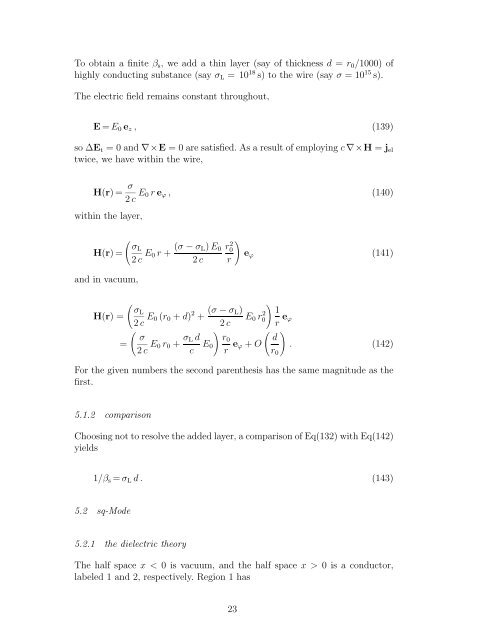pdf-file - Institut für Theoretische Physik
pdf-file - Institut für Theoretische Physik
pdf-file - Institut für Theoretische Physik
Create successful ePaper yourself
Turn your PDF publications into a flip-book with our unique Google optimized e-Paper software.
To obtain a finite βs, we add a thin layer (say of thickness d = r0/1000) of<br />
highly conducting substance (say σL =10 18 s) to the wire (say σ =10 15 s).<br />
The electric field remains constant throughout,<br />
E = E0 ez , (139)<br />
so ∆Et = 0 and ∇×E = 0 are satisfied. As a result of employing c ∇×H = jel<br />
twice, we have within the wire,<br />
H(r)= σ<br />
2 c E0 r eϕ , (140)<br />
within the layer,<br />
H(r)=<br />
and in vacuum,<br />
<br />
σL<br />
2 c E0 r + (σ − σL) E0<br />
2 c<br />
r 2 0<br />
r<br />
<br />
eϕ<br />
(141)<br />
<br />
σL<br />
H(r) =<br />
2 c E0 (r0 + d) 2 (σ − σL)<br />
+ E0 r<br />
2 c<br />
2 <br />
1<br />
0<br />
r eϕ<br />
<br />
σ<br />
=<br />
2 c E0 r0 + σL d<br />
c E0<br />
<br />
r0<br />
r eϕ<br />
<br />
d<br />
+ O . (142)<br />
For the given numbers the second parenthesis has the same magnitude as the<br />
first.<br />
5.1.2 comparison<br />
Choosing not to resolve the added layer, a comparison of Eq(132) with Eq(142)<br />
yields<br />
1/βs = σL d. (143)<br />
5.2 sq-Mode<br />
5.2.1 the dielectric theory<br />
The half space x0 is a conductor,<br />
labeled 1 and 2, respectively. Region 1 has<br />
23<br />
r0
















